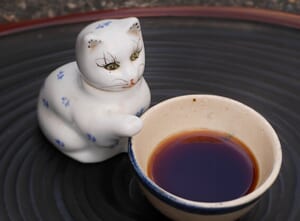Shoyu

It may be something of a surprise to learn that soy sauce is a relatively new addition to Japanese cuisine. Although a primitive form, hishio was made in the Yayoi period (300 BC to 300 AD) by mixing salt and fish, shoyu in its current form dates back to the end of the late 1500s. A document dating back to 1588 records 15 thousand liters of tamari shoyu being sent from Kishu, today’s Wakayama Prefecture, to Osaka. It only achieved widespread popularity somewhere between 1603 and 1867 when it was first exported to Europe. Unsubstantiated rumor has it that Louis XV was one of the west’s first avid shoyu fans.
Twentieth century mass production made a household name out of Kikkoman, and that company has been spectacularly successful in promoting the daily use of Japanese shoyu beyond its native shores. However shoyu is still made, using traditional methods, at small companies, described as kura (literally, warehouses) throughout the country.
Japanese soy sauce comes in two primary forms: the dark brown ‘thicker taste’ koikuchi shoyu, and the chestnut-coloured ‘thinner’, much saltier usukuchi shoyu (which uses lightly-roasted wheat, and is sweetened and made paler by the addition of mirin). Koikuchi is used for a variety of applications, especially in the Kanto region around Tokyo, and is perfect for teriyaki, where meat or fish is brushed with shoyu, mirin and sugar, and grilled. The aromatic usukuchi shoyu, a favourite of the Kansai region, is best suited to clear soups and white fish. It is especially important in enhancing the color of a dish’s ingredients.
Regional variations include the aforementioned thick, wheat-free tamari shoyu, which contains only soybeans and salt. It was once the soy sauce made in rural homes, but is now comparatively rare. It is generally made in Central Honshu, particularly in Fukushima Prefecture, and is used mostly with sashimi, and in making the sauce for unagi no kabayaki grilled eel.
Shottsuru made in Akita Prefecture, Ishikawa Prefecture’s ishiru or ishiri, and Kagawa’s ikanago are all soy sauces made from fish, somewhat similar to the nam pla of Thailand and Vietnam’s nuoc mam.
The importance of shoyu lies not merely in its use as a condiment. It is integral to many cooking and pickling processes, and an essential element of tsuyu the linchpin dipping sauce of Japanese noodle cuisine.
